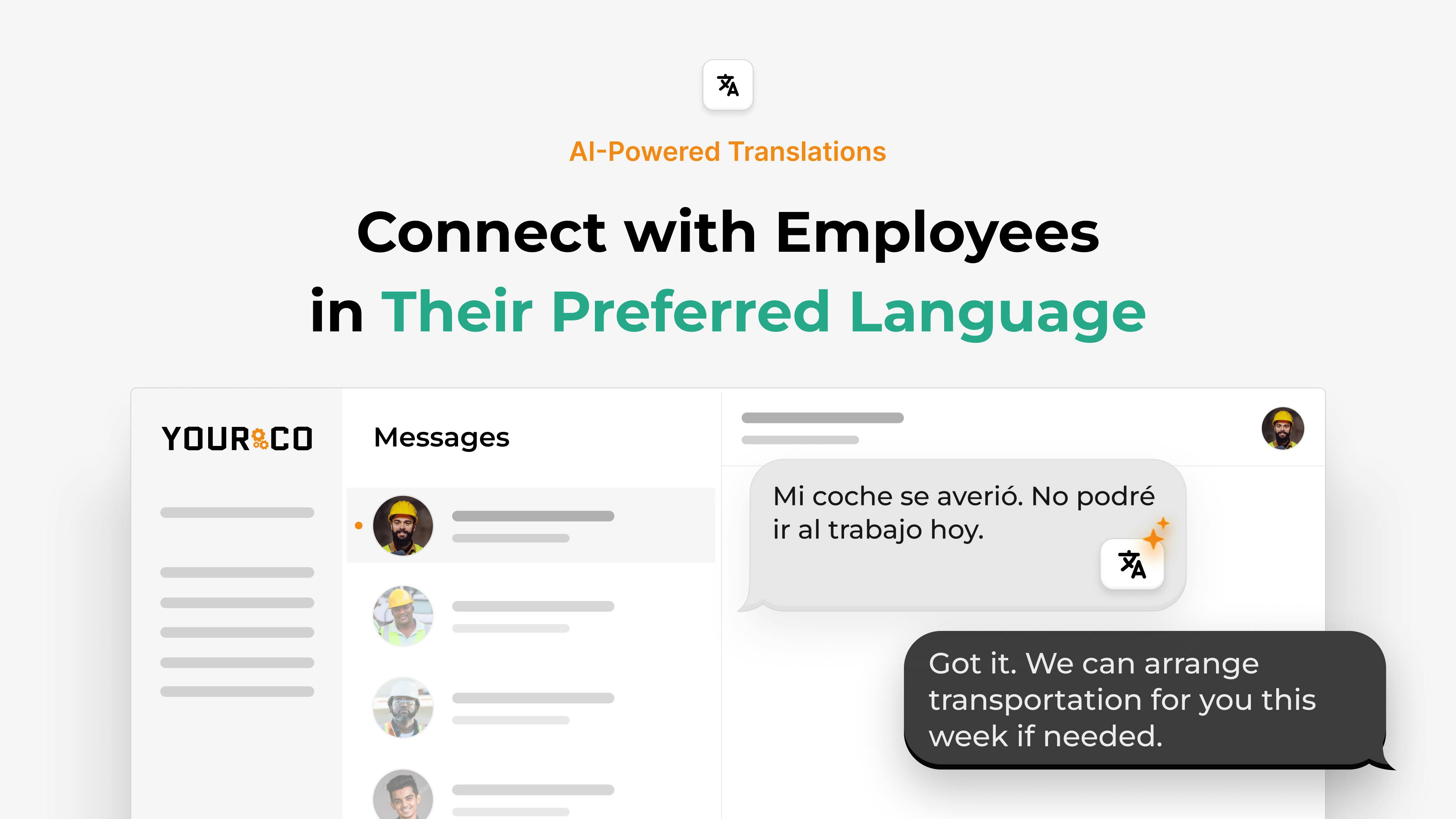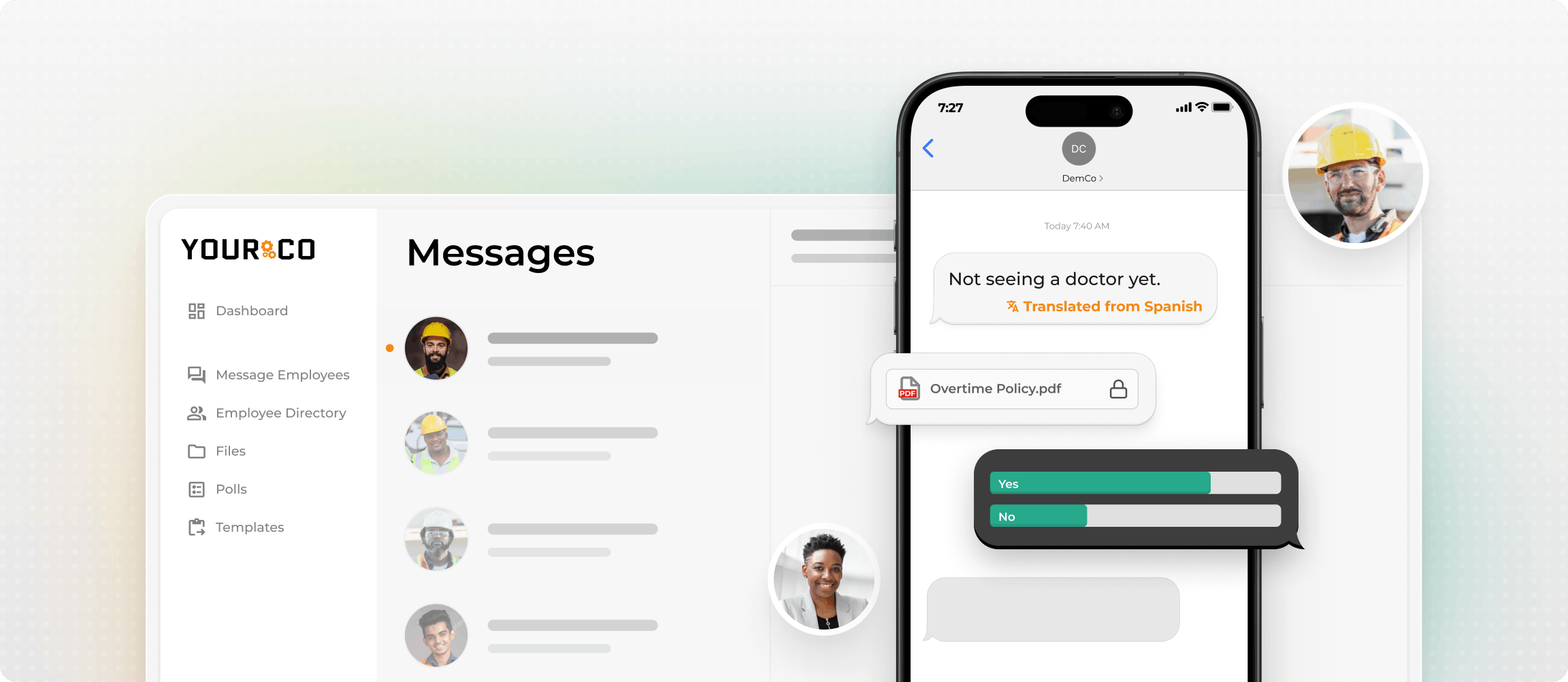Best Onboarding Checklist for Hospitality Staff


Your best server quit after three days. The new housekeeper can't find the supply closet. The front desk trainee walked out during rush hour.
Sound familiar? Poor onboarding costs you money through guest complaints, overtime coverage, and endless rehiring cycles. When new hospitality staff feel lost or unprepared, the damage spreads fast across your entire operation.
The fix is giving new employees clear directions, quick wins, and genuine support from day one. But executing this isn't simple when front-desk agents, line cooks, and room attendants work different shifts, sometimes speak different languages, and rarely check emails.
This 15-step checklist shows you exactly how to onboard hospitality staff who stick around and perform well. Each step includes specific actions you can implement immediately, plus SMS-based solutions that actually reach your frontline team.
Pre-Hire Setup
1. Pre-Arrival Communication & Paperwork
Goal: Handle paperwork before day one so new hires walk in confident and prepared
Nothing kills confidence faster than scrambling through forms during the first shift. Start with a simple text message listing exactly what you need:
- I-9 and W-4 forms
- Direct-deposit information
- Food-handler permits and alcohol-service certifications
- Any state or union documents
Why text works: 98% open rate vs. 20% for email. You can also schedule text reminders for anyone who hasn't responded, which prevents no-shows.
Action Steps:
- Send digital welcome packet via SMS (property map, first-week schedule, break room basics)
- Let employees text photos of completed forms to your company number
- Include answers to common first-day questions
- No portals or passwords needed — just click and read
With admin tasks handled upfront, you can spend their first shift focused on actual training.
2. Role Clarity & Job Expectations
Goal: Define exactly what each job looks like to prevent confusion
When new hires know where their responsibilities begin and end, they get up to speed faster and make fewer mistakes. Spell out specifics to avoid the common "that's not my job" confusion that slows operations.
Core Responsibilities by Role:
- Front desk agents: Greet guests, handle reservations, process payments
- Housekeeping staff: Clean rooms, restock amenities, flag maintenance issues
- Food service hosts: Manage tables, control wait times, assist servers
Action Steps:
- Create role-specific checklists and text them before day one
- Include uniform requirements, start times, and first-shift goals
- Send daily objective texts during shifts ("focus on upselling desserts tonight")
- Enable two-way texting so employees can ask quick questions in their preferred language
Short reminders keep priorities clear without pulling staff away from guests.
First Day Essentials
3. Uniform & Grooming Standards
Goal: Professional appearance that builds guest trust from day one
Clear dress code standards eliminate guesswork and help new hires feel prepared. Text each new hire a simple uniform guide tailored to their role:
Uniform Guidelines:
- Front-desk staff: Blazers, pressed slacks, closed-toe shoes, visible name tags
- Housekeepers: Breathable polos, knee-length shorts or trousers, slip-resistant footwear
- Kitchen and bar crews: Chef whites or black server shirts with aprons, hair restraints, non-slip shoes
Grooming Checklist: Hair tidy and pulled back if it touches the collar, neutral jewelry (one watch or wedding band), tattoos covered unless brand guidelines allow, unscented or light fragrance, fresh hygiene each shift.
Pro Tip: Take photos of properly dressed team members, store them in a cloud folder, and share the link via SMS. Use AI translation to send these standards in multiple languages to keep instructions clear across language barriers.
4. Property Tour & Facilities Orientation
Goal: Prevent confusion and ensure safety knowledge
New hires feel overwhelmed walking into an unfamiliar property. A well-planned tour makes all the difference and prevents the frantic searching that happens when someone needs help fast.
Essential Tour Stops:
- Lobby, guest corridors, restaurant, staff areas
- Break room, storage closets, loading dock
- Safety equipment: fire extinguishers, first-aid kits, emergency exits
Action Steps:
- Send property map via text before their shift starts
- Include links that open directions on any phone
- Set up location-based messages for larger properties ("You're in Building B — break room is on level 2")
- Get thumbs-up confirmation they completed the tour
That simple text creates a record showing the employee saw every emergency route and safety feature.
5. Guest Service Protocols
Goal: Consistent service standards that create memorable experiences
New hires must master service fundamentals quickly. The foundation includes greeting guests by name within five seconds, maintaining eye contact, and following a straightforward service recovery process: apologize, own the issue, fix it, and follow up.
Role-Specific Training:
- Hotel receptionists: Handle welcomes, reservations, payment processing
- Housekeepers: Represent your brand with cleaning standards and maintenance escalation
- Food and beverage staff: Manage table flow, handle orders, address allergen inquiries, identify upselling opportunities
SMS Reinforcement:
- Send brief scenarios like "A guest's room isn't ready at check-in — what's your response?"
- Follow up with ten-minute floor practice sessions
- Use polling to confirm understanding across the team
Text-based micro-learning ensures critical information reaches every team member consistently.
6. Safety & Emergency Procedures
Goal: Keep both guests and staff out of harm's way
A clear safety routine protects everyone and meets compliance requirements. Start with four essentials: fire safety, medical emergencies, severe weather, and security threats.
Training Requirements:
- Walk recruits to each alarm pull, first-aid kit, and storm shelter
- Spell out how to report accidents, injuries, or near-misses
- Keep the process simple: quick call to manager, written incident log, SMS confirmation for time-stamped records
- Use incident report templates for consistency
Emergency Communication: When emergencies hit, speed beats everything. Broadcast SMS lets you alert every employee in seconds without clogging phones with replies. If your team spans multiple languages, instant translation pushes the same alert in Spanish, Tagalog, Mandarin, or any other language.
Employees can text photos and notes about incidents directly to your company number, creating instant, searchable records. Document every training session with digital sign-offs that meet most insurers' safety requirements.
Department-Specific Training
7. Food Safety & Handling
Goal: Protect guests and maintain health department compliance
Food safety standards protect guests and keep your operation running smoothly. Teaching clear protocols from day one prevents violations and builds good habits.
Essential Training Points:
- Safe temperature controls for storage, cooking, cooling, and reheating
- Cross-contamination prevention through clean surfaces, color-coded boards, proper handwashing
- Allergen awareness, including accurate labeling and separate prep areas
SMS Implementation:
- Send these points as a primer before the first shift
- Reinforce with daily checklists employees complete by replying "done"
- Send mid-shift reminders: "Temp log due now" at 2 p.m. during busy service
Every checklist response gets stored alongside each employee's profile, creating a time-stamped record for surprise audits. Inspectors can see proof of adherence without rifling through binders.
8. Technology & Systems Access
Goal: Get employees productive immediately without bottlenecks
Give new hires the right logins on day one, and they can welcome guests without hovering over a supervisor. Miss this step and you create bottlenecks at the front desk during busy periods.
Essential Systems:
- Property Management System (PMS) for reservations and room status
- Point of Sale (POS) for food and beverage orders and payments
- Scheduling or time-clock software for clock-ins and shift swaps
- Housekeeping task dashboard and guest messaging platform
Action Steps:
- Text each employee their username, temporary password, and one-click password change link
- SMS gets read within minutes, so critical credentials land where they'll be seen immediately
- Include short links to 90-second "how it works" videos or step-by-step guides
- Handle mid-shift password resets via quick reply text
System integration means you enter employee data once, and any future outage or upgrade alert can be broadcast instantly.
Integration & Support
9. Buddy Program & Shadow Shifts
Goal: Transform overwhelming information dumps into practical learning
Pairing each recruit with a seasoned "buddy" provides real-world guidance from someone who knows the job inside out. Choose buddies who model your service standards and work the same shift pattern as the new hire.
Structured Shadowing Approach (First 3 Shifts):
- Pre-shift setup and uniform check
- Greeting guests and service recovery steps
- Safe use of equipment and cleaning chemicals
- Closing tasks and hand-off to next team
SMS Coordination:
- Send quick brief to both parties explaining expectations and timeframe
- Text surveys after each shift asking what clicked and what needs clarification
- Responses flow directly back to you for instant progress tracking
This approach helps you address knowledge gaps before frustration builds.
10. Cultural Awareness & Diversity Training
Goal: Confident service for guests from diverse backgrounds
Hospitality teams serve guests from everywhere, and your staff needs to feel confident interacting with people from different backgrounds. Cultural awareness training helps your frontline crew avoid awkward moments and build genuine connections.
Practical Training Focus:
- Common greetings and body language differences
- Dietary needs like kosher or halal requests
- When some guests prefer not to shake hands while others expect direct eye contact
Multilingual Resources: For diverse teams, use specialized guides:
- Onboarding Spanish-speaking employees
- Onboarding Tagalog-speaking employees
- Onboarding Vietnamese-speaking employees
- Onboarding Chinese-speaking employees
Language-specific onboarding reduces confusion and shows new hires you value their background from day one.
SMS Integration: Text your team a quick scenario each week with follow-up explanations they can reference later. Since messages translate instantly, every team member gets the same clear guidance.
11. Multilingual Communication Protocol
Goal: Clear communication for all employees regardless of language
You can't run smooth operations if half your crew doesn't fully grasp daily instructions. Many hospitality teams speak a mix of languages, so knowing who speaks what becomes your foundation.
Start by identifying which languages your team needs most. Many hospitality operations benefit from targeted onboarding resources in Spanish, Tagalog, Vietnamese, and Chinese—the most common languages among hospitality employees. Dedicated language-specific onboarding guides ensure critical safety and service information reaches every team member clearly.
Implementation Steps:
- Add "primary language" field to every employee record during hiring
- Use Yourco's automatic translation to each employee's preferred language—no app downloads or internet required
- Unlike mobile apps that create barriers for non-desk employees, SMS works on any phone, including basic flip phones
Best Practices:
- Keep writing translation-friendly with short sentences and no slang
- Before rolling out new policies, test comprehension with quick polls
- High read rates make it easy to spot gaps and follow up individually
12. HR & Benefits Enrollment
Goal: Complete paperwork efficiently without overwhelming new hires
Make benefits enrollment as straightforward as clocking in. Give new hires a clear checklist and deliver every task through quick texts.
Essential Benefits to Cover:
- Health insurance choices and enrollment deadlines
- Retirement plan signups and company matching
- PTO policies and request procedures
- Employee discounts for meals or rooms
Action Steps:
- Text each item with due dates and short links to forms
- Send timed nudges to keep the process moving
- Enable two-way messaging for questions the moment they hit a snag
- Digital sign-offs replace paper stacks and flow into secure employee files
Employees confirm policy understanding by replying "YES" to each text—all responses get timestamped and logged automatically. When someone falls behind, friendly automated reminders continue until complete.
Ongoing Development
13. Performance Check-Ins (30/60/90)
Goal: Address issues before they become problems and build retention
Regular check-ins prevent small issues from becoming big problems. Schedule conversations strategically: day 3 for initial impressions, week 2 for deeper discussion, then formal sit-downs at 30, 60, and 90 days.
Check-In Process:
- Send brief SMS surveys before each meeting asking employees to rate confidence and share concerns
- Text messages get read almost immediately, so you won't miss important feedback
- Responses create easy-to-review summaries and highlight common challenges across your team
- For simple requests like time-off, managers can approve directly via text
When new hires see their input leads to actual changes, they stick around longer and develop stronger skills that benefit your entire operation.
14. Feedback Loop & Process Improvement
Goal: Continuously improve your onboarding based on real employee input
Make it clear from day one that new hires' opinions matter. Right after orientation, send a short, anonymous survey via SMS to get first impressions.
Feedback Schedule:
- Post-orientation: Immediate reactions ("Was today's property tour clear?")
- Day 7, 30, 90: Progress and gap identification
- Anonymous options for honest input about management or processes
Closing the Loop: When multiple housekeepers mention late uniform deliveries or several servers point out POS training gaps, you can spot patterns and fix them fast. Send "You spoke, we fixed it" texts when you make changes, like adding multilingual safety videos or moving benefits sessions earlier.
All responses land in one dashboard so you can track improvements over time.
15. Cross-Training & Growth Opportunities
Goal: Build flexible, engaged team with backup coverage
Staff who understand multiple roles stay longer and help you cover gaps when someone calls out sick. When your best server suddenly needs time off and you're figuring out how to fill shifts, cross-training provides solutions.
Implementation Strategy:
- Map essential tasks across departments (front desk check-ins to food service standards)
- Focus on tasks newcomers can learn quickly before moving to technical duties
- Text messaging makes scheduling shadow shifts simple: "Two spots open to shadow housekeeping Tuesday morning — text HOUSE to join"
Progress Tracking:
- Basic log: date, department, skills learned, confidence level
- Handle call-offs more efficiently with cross-trained backup
When your team understands how different departments work, guest service flows better and scheduling gets easier. Cross-training also shows employees you're serious about their growth.
Implement SMS-Based Onboarding Today
Effective hospitality onboarding requires reaching every employee instantly, regardless of shift, location, or language. Traditional methods fail because they assume desk access and email habits your frontline team doesn't have.
Why SMS-Based Onboarding Works:
- 98% open rates vs. 20% for email—your training actually gets seen
- Works on any phone—no app downloads, passwords, or internet required
- Instant translation in 135+ languages for multilingual teams
- Two-way communication for questions and confirmations in real-time
Yourco delivers scheduled training sequences, automatic translations, and secure storage for compliance tracking. New employees receive personalized welcome messages, first-day guidance, and can ask questions anytime—no technical skills needed.
Unlike mobile apps that require downloads, passwords, and training, Yourco works instantly on any phone. Your team receives shift reminders and safety alerts via text, while new hires can snap photos of completed forms and send them directly to your company number.
Ready to eliminate onboarding bottlenecks? Try Yourco free today—no app downloads or training required for your team. Or schedule a demo to see how SMS transforms hospitality training.
Frequently Asked Questions
Why does structured onboarding matter so much in hospitality? A clear process gives new hires the tools, mentors, and safety training they need from day one. When you set expectations early, you reduce costly early departures, keep guest satisfaction high, and avoid the endless cycle of recruiting and retraining.
How can SMS help me train a multilingual team? Text messages reach almost everyone, including staff who rarely check email. SMS lets you send quick instructions, training video links, and last-minute shift updates in each employee's preferred language. Two-way texting gives new hires an easy way to ask questions privately.
Which roles need the clearest job expectations? Front desk agents, housekeepers, servers, and maintenance staff interact with guests or guest spaces every shift. Even small mistakes become visible quickly in these positions. Give these high-visibility roles specific checklists outlining daily tasks and service standards.
What safety topics should every new hire cover? Start with the basics: fire exits, first-aid locations, and incident reporting via SMS. Yourco lets employees text photos and notes about safety issues directly to your company number, creating instant, timestamped records that meet compliance requirements.
How do I stay on top of expiring certificates and documents? Move paperwork online so licenses, food-safety cards, and work-eligibility forms live in one dashboard. A digital system flags upcoming expirations, sends automated renewal reminders, and stores new uploads immediately.





